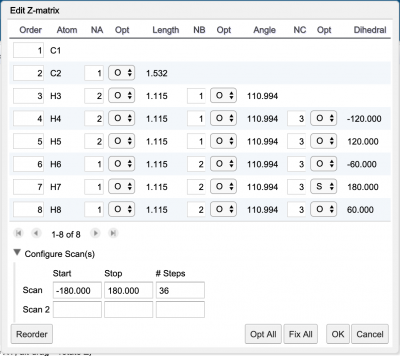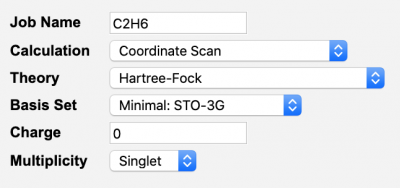Difference between revisions of "Intro WebMO 3"
Jump to navigation
Jump to search
(Created page with "(4/9/20, bes) in progress...") |
|||
| (2 intermediate revisions by the same user not shown) | |||
| Line 1: | Line 1: | ||
(4/9/20, bes) | (4/9/20, bes) | ||
| − | in | + | '''''Exercise 3 - Study of Rotation Barrier Energy about Carbon-Carbon Bonds''''' |
| + | |||
| + | ===Coordinate Scan of Ethane=== | ||
| + | :- Build ethane, C<sub>2</sub>H<sub>6</sub>. You can choose to add hydrogen by selecting H from the periodic table or by allowing WebMO to do it for you when it cleans up the structure. Remember to symmetrize if necessary (if symmetrize icon is red, click it). | ||
| + | :- Before submitting this job, choose Tools > Z-matrix to open the Z-matrix Editor window. In this window, each atom is numbered. The corresponding number appears on the molecule sketch in the Build Molecule window. Identify the two H atoms that form a dihedral angle (H-C-C-H) of 180°. In my case, but maybe not yours, my atoms were numbered 7H-1C-2C-3H. It may help to rotate the molecule. In the pull-down menu to the right of this listed dihedral angle, choose “S” which stands for "scan." You will notice in the window below that the scan range is from -180 --> 180 in 36 steps...make these edits to the z-matrix as well. | ||
| + | :::[[File:Screen Shot 2020-04-09 at 2.09.32 PM.png|400px]] | ||
| + | - Setup the job as shown below and submit...what you are asking the computer to do is calculate/minimize the energy for 36 different dihedral angles (36 calculations). | ||
| + | :::[[File:Screen Shot 2020-04-09 at 2.12.33 PM.png|400px]] | ||
| + | :- Once the job is complete, click on the hyperlinked name to open the “View Job” window. | ||
| + | :- Scroll down to the Coordinate Scan table and click on the magnifying glass on the table title bar; a "coordinate scan" window opens showing the plot of Energy vs. dihedral angle. You can switch between a molecular view and the graph using the tabs on the window. | ||
| + | :- Again, scroll down to the very bottom of the Coordinate Scan table and change the "Loop" to "Cycle", then click on the "film strip" icon at the very top of the coordinate Scan table. While the molecule is stepping thru all of the calculated structures, note the energy is shown in the bottom left corner. | ||
| + | |||
| + | Does the graph make sense? Do you recall [https://en.wikipedia.org/wiki/Gauche_effect gauche] and anti conformations? | ||
| + | |||
| + | ===Coordinate Scan of 1,2-difluoroethane=== | ||
| + | Repeat the above for 1,2-difluoroethane. | ||
Latest revision as of 18:48, 10 April 2020
(4/9/20, bes)
Exercise 3 - Study of Rotation Barrier Energy about Carbon-Carbon Bonds
Coordinate Scan of Ethane
- - Build ethane, C2H6. You can choose to add hydrogen by selecting H from the periodic table or by allowing WebMO to do it for you when it cleans up the structure. Remember to symmetrize if necessary (if symmetrize icon is red, click it).
- - Before submitting this job, choose Tools > Z-matrix to open the Z-matrix Editor window. In this window, each atom is numbered. The corresponding number appears on the molecule sketch in the Build Molecule window. Identify the two H atoms that form a dihedral angle (H-C-C-H) of 180°. In my case, but maybe not yours, my atoms were numbered 7H-1C-2C-3H. It may help to rotate the molecule. In the pull-down menu to the right of this listed dihedral angle, choose “S” which stands for "scan." You will notice in the window below that the scan range is from -180 --> 180 in 36 steps...make these edits to the z-matrix as well.
- Setup the job as shown below and submit...what you are asking the computer to do is calculate/minimize the energy for 36 different dihedral angles (36 calculations).
- - Once the job is complete, click on the hyperlinked name to open the “View Job” window.
- - Scroll down to the Coordinate Scan table and click on the magnifying glass on the table title bar; a "coordinate scan" window opens showing the plot of Energy vs. dihedral angle. You can switch between a molecular view and the graph using the tabs on the window.
- - Again, scroll down to the very bottom of the Coordinate Scan table and change the "Loop" to "Cycle", then click on the "film strip" icon at the very top of the coordinate Scan table. While the molecule is stepping thru all of the calculated structures, note the energy is shown in the bottom left corner.
Does the graph make sense? Do you recall gauche and anti conformations?
Coordinate Scan of 1,2-difluoroethane
Repeat the above for 1,2-difluoroethane.

